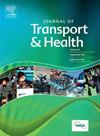How learning to cycle influences lifestyle: An eight country pooled analysis and person-centered approach
IF 3.3
3区 工程技术
Q2 PUBLIC, ENVIRONMENTAL & OCCUPATIONAL HEALTH
引用次数: 0
Abstract
Introduction
Cycling plays a key role in the promotion of individual, community, and planetary health. However, no previous study has explored the interplay between the process of learning to cycle and cycling habits, adopting a person-centered approach. To understand which variables promote the learning process (i.e., acquisition) and lifelong bicycle use on a daily and recreational basis (i.e., engagement), the aim of this study was to identify different clusters of individuals with similar characteristics related to their cycling acquisition and engagement.
Methods
A cross-country pooled sample of 8542 individuals aged 28.9 ± 14.4 years (58.5 % female) was assessed via online questionnaire. A Self-Organizing Map (SOM) was used to classify and visualize the values of individuals in the variables tested.
Results
A K-means cluster analysis resulted in seven profiles. Participants in profiles characterized by a relatively old age to learn to cycle (i.e., 7-8 years-old; n > 1500 mainly from Mexico and the United Kingdom) typically learned to cycle on a conventional bicycle, were taught by their father, mother, or both, and mainly cycle for leisure. Participants in profiles characterized by a relatively young age to learn to cycle (i.e., 5 years old; n > 1500 mainly from Belgium and Finland) typically learned to cycle by using a wide variety of bicycles (i.e., balance-bicycle, two-training wheels, one-training wheel and conventional bicycle) and without guidance from a specific significant other.
Conclusion
The identified clusters highlight the diversity of cycling engagement across different demographics and geographic locations. The results provide valuable insights to plan and guide targeted policies and interventions to promote cycling as a mode of transportation and recreational activity.
学习骑车如何影响生活方式:八个国家汇总分析和以人为本的方法
自行车在促进个人、社区和地球健康方面发挥着关键作用。然而,以往的研究并没有采用以人为本的方法来探讨骑车学习过程与骑车习惯之间的相互作用。为了了解哪些变量促进了学习过程(即习得)和终身自行车的日常和娱乐使用(即参与),本研究的目的是确定与自行车习得和参与相关的相似特征的不同个体群。方法采用在线问卷调查的方式,对全国8542名年龄28.9±14.4岁的个体(58.5%为女性)进行调查。使用自组织映射(SOM)对被测变量中的个体值进行分类和可视化。结果k -均值聚类分析得到7个特征。参与者在学习骑自行车的年龄相对较大(即7-8岁;n比;1500年(主要来自墨西哥和英国)典型地学会骑传统的自行车,由他们的父亲,母亲或两者教,主要是为了休闲。参与者档案的特点是学习骑自行车的年龄相对较小(即5岁;n比;1500年(主要来自比利时和芬兰)通常通过使用各种各样的自行车(即平衡自行车,双辅助轮,单辅助轮和传统自行车)来学习骑自行车,并且没有特定的重要他人的指导。结论所识别的集群突出了不同人口统计和地理位置的自行车参与的多样性。研究结果为规划和指导有针对性的政策和干预措施提供了有价值的见解,以促进自行车作为一种交通和娱乐活动的模式。
本文章由计算机程序翻译,如有差异,请以英文原文为准。
求助全文
约1分钟内获得全文
求助全文

 求助内容:
求助内容: 应助结果提醒方式:
应助结果提醒方式:


